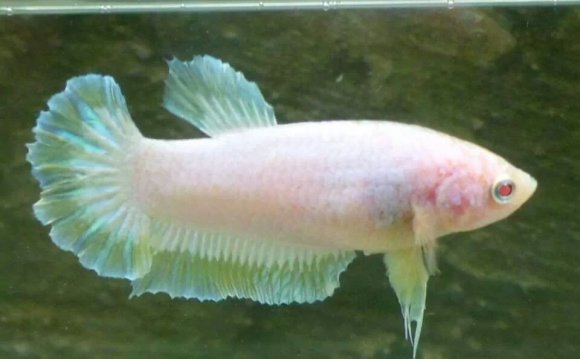
Due to selective breeding, the ever popular male, or Siamese Fighting Fish, is now available in an enormous array of colours and tail types. Detailed below you will find the different terms put to these tail types, patterns and colours and how some of them have come about. There will always be some Bettas that break the rules and don't quite fit into any of the categories below!
Veil Tail (VT)
The most common type of tail type you will ever come across in pet stores is the Veil Tail. This type of tail is long, with a long anal and dorsal fin also, and droops down from the caudal peduncle. In breeding, a veil is dominant over other tail types and is therefore undesirable when breeding show Bettas. The term "veil tail" is often abbreviated to "VT". Veil Tails are now no longer accepted in the show Betta circuit due to their bloodlines being diluted by excessive breeding for the pet store market.
Plakat (PK)
The Plakat, or Plakad, is a short-tailed Betta, and is the most closely related to wild Betta splendens or traditional fighting Bettas. Plakats can often be mistaken for female Bettas to the untrained eye, however, males will display elongated ventral fins, a rounded caudal fin and a sharply pointed anal fin. The term Plakat is often abbreviated to "PK". There are 3 sub-categories related to this tail type. There is the traditional Plakat where the tail is rounded, sometimes with a point. Now, due to selective breeding and crossing, there is also the Half Moon Plakat (or "HMPK") where the tail has a 180 degree spread when flared and the Crown Tail Plakat (or "CTPK") has the tail is either rounded or with a 180 degree spread and with elongated rays giving it a "spiky" appearance.
Crowntail (CT)
The Crowntail, abbreviated to CT, has become a hugely popular tail type variation. It is unlike any other in the sense that the rays are extended to varying degrees on all fins giving the fish a "spiky" appearance. In show standards, for a fish to be classed as a Crowntail there has to a minimum of 33% reduction in webbing. The reduction on the webbing on CT Bettas also varies vastly, sometimes it can be quite full, some times dramatically reduced so only the rays are left. There are three recognised types of crowntail, the double ray, the single ray and the crossed ray. Crossed rays are the most desirable and the most expensive to purchase. There have also been lesser known variations such as the triple ray, even the quadruple ray! Crowntails can have their tails in a full 180 degree spread, or less than a 180 degree spread depending on their breeding. CT's are prone to fin curling, especially those with little webbing, if their water is not kept immaculate. Breeders are known to "sun bathe" their Bettas for an hour or so in order to keep their rays straight. It has been found also that when breeding, CT's have a heightened amount of aggression compared to other tail types, which can make it challenging to get a successful spawn.
Half Moon (HM)
The Half Moon, or "HM" is a very desirable tail type. It is characterised by having the full 180 degree spread when flared, forming a "D" shape with straight edging. Dorsal and anal fins are also dramatically larger than those on other fin types. HMs are prone to tail-biting and fin damage, their tails are large and unnatural and HMs often feel hampered down by their fins. This also means they're one of the hardest tail types to breed as the males find it hard to successfully wrap the females.
Deltas (D) & Super Deltas (SD)
Deltas (or "D") and Super Deltas (or "SD") are very similar to HM's but have less than a 180 spread when flared. Super Deltas are nearly an HM but not quite, Deltas are far less than an HM. Deltas and Super Deltas are differentiated from Veil Tails by the fact that if you drew a line from the nose to the tip of the caudal fin, on a Delta or Super Delta there would be an equal amount of fin on either side of the line, whereas on a Veil Tail there would be little tail at the top, and the majority below.
Double Tail (DT)
The Double Tail (or "DT") can be seen combined with Plakats, Halfmoons and even Crowntails. It is a genetic trait that causes the caudal fin to grow into two lobes rather than one. The genes that cause this also cause the body to be shorter and the dorsal and anal fins to be very broad. As the body is effectively stunted in length, DT's are more prone to swimbladder problems and this also affects fry survival rates.
Combtail
The Combtail (no abbreviation) is a cross of a Crowntail and another tail type. With selected breeding a combtail can be bred into a crowntail, but may still carry a dominant gene such as the VT. They often have the typical droop of the Veil tail but combined with some extended rays on all fins to varying degrees.









